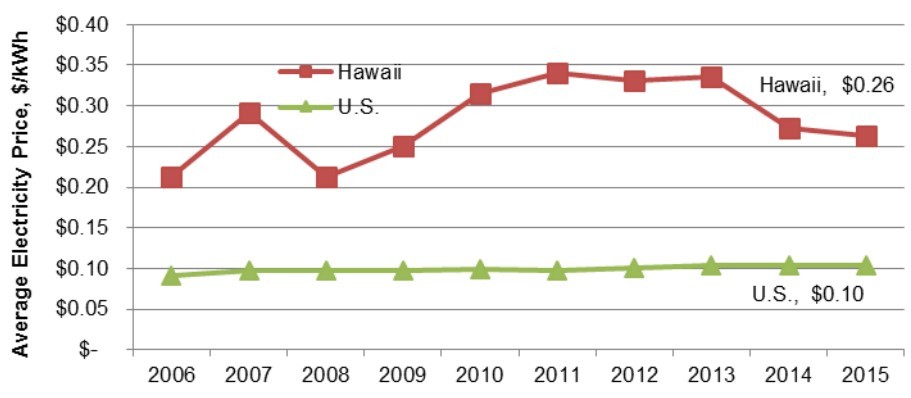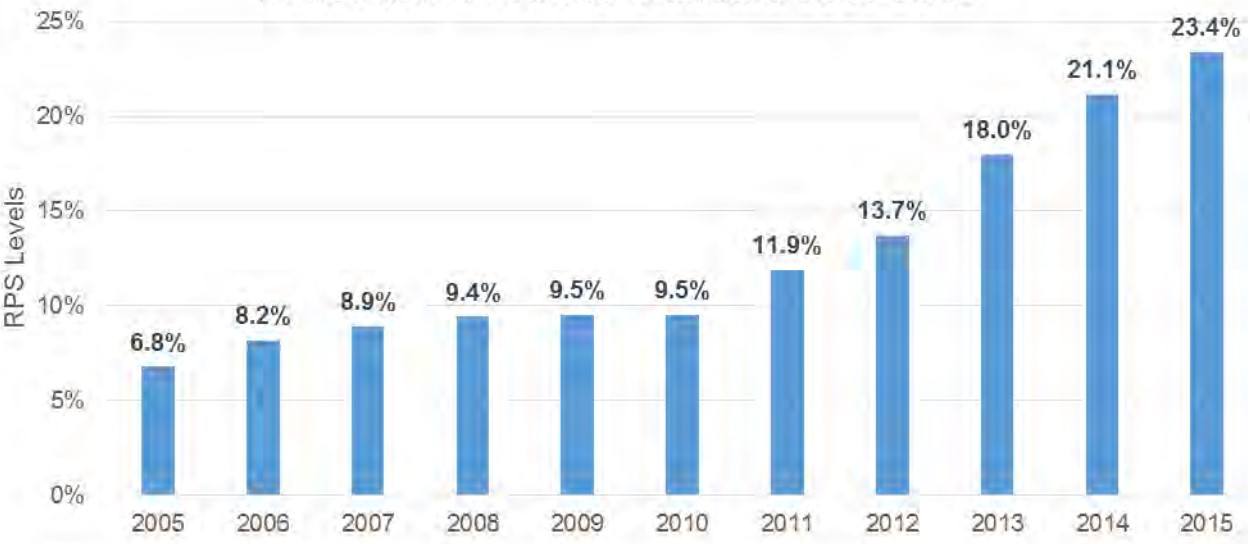Hawaii Leads the March Towards 100% Renewable Energy

Hawaii has the highest electricity costs in the nation, making it uniquely motivated to lead the country in seeking 100% renewable energy generation by 2045.
Hawaiians pay 2.25x the national average and 30% more than the next closest state (Alaska) for their electricity usage due to Hawaii’s unique geographic constraints [1]. Driving that cost is Hawaii’s unique need to burn oil for electricity, using oil for about 70% of its energy needs versus less than 1% for the rest of the country [2]. These high costs mean the economics of shifting to renewables are much more favorable for Hawaii than other states. Consequently, the state is poised to build the blueprint for other states to follow in shifting its energy usage to renewable sources.
Figure 1. Hawaii’s Electric Costs Relative to the U.S. Average from 2006 – 2015 [3]
Figure 2. 2014 Electricity Production by Source [3]
Hawaiian Electric Industries
Hawaiian Electric Industries (HEI), a publically owned utility, is on the vanguard of the renewable shift. Hawaii state legislators, with the support of HEI, passed a 2015 law mandating that renewable sources contribute to 70% of all electricity sold in 2040 with an increase to 100% by 2045 [4]. While this is an aggressive goal, Hawaii benefits from lots of sunshine and wind and stands to gain the most from energy efficiencies.
Solar and wind energy make up a respectable percentage of Hawaii’s energy sources (6%, excluding customer rooftops [5]), but some nontraditional sources are contributing as well. In 2015, 5.6% of Oahu’s power came from solid waste [6]. The Honolulu Program of Waste Energy Recovery (H-POWER), a state owned facility, burns 3,000 tons of garbage per day in a furnace that powers a turbine generator. Not only is this a renewable energy source, but it also reduces trash sent to the landfill by 90% [7]. Additionally, HEI captures underground volcanic heat to produce geothermal power, which contributes to 20.2% of Hawaii County’s electricity [8].
Challenges to Transitioning to Renewable Energy Sources
Hawaii’s transition to renewable energy has not been without its challenges. The inability to store energy produced by renewables has led to two major problems. The first is the traditional problem of struggling to match supply and demand during peak demand periods. The second is residential solar panel customers generating excess power and sending it back through the grid. On Oahu, 13% of homes have solar panels and residents produce almost four times more solar power than the next highest state (California) [9]. Not only is this straining the grid, designed to be a one way path of electricity, but it also means that thousands of customers are receiving rebate checks from HEI instead of paying a monthly bill. In a twist similar to what is happening in states with a large electric/hybrid car presence where customers are paying less in gas taxes and causing a road maintenance shortfall, HEI is left paying customers who are both not contributing towards revenue and straining the system. As a result, HEI stopped accepting customer requests to install solar panels and asked the state to cut rebate payments in half [10]. Customers were outraged and confused by this response, with some leaving the grid completely, a rather serious concern for HEI [11].
A Unique Elon Musk / SolarCity / Tesla Partnership
HEI has responded to the power storage problem by contracting with Elon Musk’s SolarCity to build a 13-megawatt solar farm combined with Tesla batteries in Kauai that will provide about a quarter of that island’s midday power needs [12]. Not only is HEI demonstrating bold initiative by being the first utility to attempt to store renewable energy on a large scale, it is also saving money as it will pay SolarCity only 14.5 cents per kilowatt hour versus the average current cost of 24.2 cents [13].
Paying for Progress
Customer costs are a significant concern for both HEI and the Hawaiian government and they know the shift to renewables will be gradual. HEI, without the support of the Hawaiian Governor, has decided to pursue an intermediate option of replacing fossil fuels with liquid natural gas, which will be less costly than switching immediately to renewables while also delivering cleaner energy [14]. The utility feels this intermediate step is necessary because they will not have the budget for the capital expenditures necessary to shift immediately to renewables. The expected capital expenditures under the renewable plan over the next 30 years are $25.8 billion, with $13.6 billion coming from HEI and the remainder from customer bills and state tax incentives [15].
Achieving Results
Hawaii’s march towards 100% renewables has been admirable to date. In 2015, renewable sources generated 23.2%* of all electricity statewide and 48.7% of electricity in Hawaii County [16]. This is even more impressive considering that in 2011, renewables made up 8.7%* of electricity sources [17]. Other states should take note by studying Hawaii’s challenges and adopting its successful practices.
Figure 3. Hawaii Renewable Portfolio 2005 – 2015 [3]
Word Count: 789
Sources
[1] “Electric Power Monthly,” U.S. Department of Energy, https://www.eia.gov/electricity/ monthly/epm_table_grapher.cfm?t=epmt_5_6_a, accessed October 2016.
[2] Rebecca Smith and Lynn Cook, “Hawaii Wrestles with Vagaries of Solar Power,” Wall Street Journal, June 18, 2015, http://www.wsj.com/articles/hawaii-wrestles-with-vagaries-of-solar-power-1435532277, accessed October 2016.
[3] “Hawaii Energy Facts and Figures,” Hawaii State Energy Office, May 2016, http://energy.hawaii.gov/wp-content/uploads/2011/10/FF_May2016_FINAL_5.13.16.pdf, accessed October 2016.
[5] Act 097, HRS 269-92, Hawaii State Law, http://www.capitol.hawaii.gov/hrscurrent/ Vol05_Ch0261-0319/HRS0269/HRS_0269-0092.htm, accessed October 2016.
[6] “Hawaii Energy Statistics,” U.S. Department of Energy, http://energy.hawaii.gov/resources/ dashboard-statistics, accessed October 2016.
[7] “About our Fuel Mix”, Hawaiian Electric Industries, https://www.hawaiianelectric.com/ clean-energy-hawaii/clean-energy-facts/about-our-fuel-mix, accessed October 2016.
[8] “H-POWER,” Hawaiian Electric Industries, https://www.hawaiianelectric.com/clean-energy-hawaii/clean-energy-facts/renewable-energy-sources/biomass/h-power, accessed October 2016.
[9] “About our Fuel Mix.”
[10] Smith and Cook, “Hawaii Wrestles with Vagaries of Solar Power.”
[11] Diane Cardwell, “Solar Battle Puts Hawaii at Forefront of Worldwide Changes,” New York Times, April 18, 2015, http://www.nytimes.com/2015/04/19/business/energy-environment/solar-power-battle-puts-hawaii-at-forefront-of-worldwide-changes.html?_r=0, accessed October 2016.
[12] Ibid.
[13] Cassandra Sweet, “Elon Musk Has Big Hopes for Storage Batteries, but the Market Is Small,” Wall Street Journal, August 8, 2016, http://www.wsj.com/articles/elon-musk-has-big-hopes-for-storage-batteries-but-the-market-is-small-1470676986, accessed October 2016.
[14] Katie Fehrenbacher, “SolarCity to Use Tesla Batteries for Project in Hawaii,” Fortune Magazine, February 16, 2016, http://fortune.com/2016/02/16/solarcity-tesla-batteries-hawaii/, accessed October 2016.
[15] “Power Supply Improvement Plans Update Report,” Hawaii Electric Industries Report, April 1, 2016, p. ES-9, https://www.hawaiianelectric.com/Documents/about_us/our_vision/ psip_executive_summary_20160401.pdf, accessed October 2016.
[16] Ibid., p. ES-13.
[17] “2015 Renewable Portfolio Standard Status Report,” Hawaii Electric Industries Report, February 26, 2016, p. 3, https://www.hawaiianelectric.com/Documents/clean_energy_hawaii/ rps_report_2015.pdf, accessed October 2016.
[18] “Renewable Energy in Hawaii,” Hawaii Economic Issues, June 2011, http://files.hawaii.gov/dbedt/economic/data_reports/reports-studies/2011-renewable-energy.pdf, accessed October 2016.
* Exact percentages vary slightly by source.
Cover Photo: Sean Reilly, “Wind Farm Controversy,” Neojourno, http://blog.hawaii.edu/neojourno/2012/10/24/wind-farm-controversy-by-sean-reilly/, accessed October 2016.






It seems like one of the key challenges for HEI is making the transition fully to renewable resources; due to a lack of capital, HEI is transition to liquid nitrogen as a stepping stone before going to renewables. As a public company, it would seem that capital should not be a problem as HEI can raise more equity or potentially take out debt. Given the potential profits available to HEI by reducing the costs for electricity, it would seem like investors would leap at the opportunity to move to renewables. Therefore, I wonder why the intermediate step to liquid nitrogen is necessary.
Thanks for the insightful post – I had no idea that Hawaii had the highest energy costs and how reliant the state is on oil!
Very interesting post AJ! I guess not all is good in paradise 😉
I’d like to build up on Kelly’s point. If I’m reading this correctly, the option of switching from Oil to LNG is being pursued because it can leverage part of the existing infrastructure as opposed to requiring an entirely new development, thus reducing capital expenses. The argument is that this is still a step in the green direction because burning natural gas contaminates less than burning oil. Yet, I can’t help but feel that all that’s being done is replacing one type of fossil fuel for another. I’m curious to hear your opinion about it. Do you see this move as actually helping fight climate change, or is it a clever marketing ploy by Hawaii and the oil & gas companies?
This is an awesome post. Hawaiian officials blocked the NextEra Energy acquisition of HEI in July 2016 on the grounds that “NextEra failed to prove its plans for HECO would be good for the state” [1]. Do you have thoughts on how this will impact HEI’s plans for switching to 100% renewable energy? HEI claims that the breakup fee has gone towards improving the local infrastructure and helping HEI move towards its renewable energy goals [2]. However, do you think it’s possible that access to a bigger balance sheet like NextEra’s would have actually benefited HEI?
On another note, do you view HEI’s partnership with AES as potentially harmful from a PR perspective? AES runs a coal powered plant in West Oahu that provides 11% of Oahu’s commercial energy supply that made the U.S. EPA’s top 10 list of facilities that released the most chemicals in the state [3]. Do you think HEI needs to push AES towards renewable production (e.g. burning biomass instead of coal) or do you think they should simply build out their own renewable capacity and then cut ties with AES?
[1] The Wall Street Journal. 2016. NextEra, Hawaiian Electric Terminate Merger Bid. [ONLINE] Available at: http://www.wsj.com/articles/nextera-hawaiian-electric-terminate-merger-bid-1468838067. [Accessed 6 November 2016].
[2] The Business Journals. 2016. HEI’s profits soar due to failed NextEra-HECO merger bid. [ONLINE] Available at: http://www.bizjournals.com/pacific/news/2016/11/04/heis-profits-soar-due-to-failed-nextera-heco.html. [Accessed 6 November 2016].
Add to My References
[3] The Business Journals. 2015. AES Hawaii coal plant faces dim future with NextEra Energy in charge. [ONLINE] Available at: http://www.bizjournals.com/pacific/blog/2015/03/aes-hawaii-coal-plant-faces-dim-future-with.html. [Accessed 6 November 2016].
Jina… mahalo for the compliment. It looks like we share a mutual affection for the aina as I enjoyed reading your post as well.
I do think the New Era deal would have been good for the state. It could have allowed HEI to accelerate its capital expenditures, but I feel like there were some sensitivities to allowing a non-Hawaiian company buy the utility.
I’m glad you pointed out the concern for the AES coal plant. I didn’t realize until I just looked it up that burning coal creates more emissions than burning oil (https://www.eia.gov/tools/faqs/faq.cfm?id=73&t=11). My hope is that AES will realize that they will have to change to compete long-term and modify its behavior.